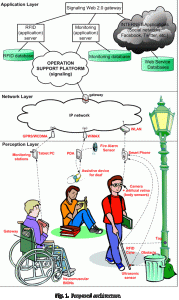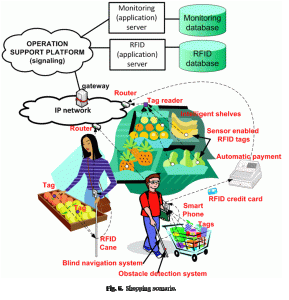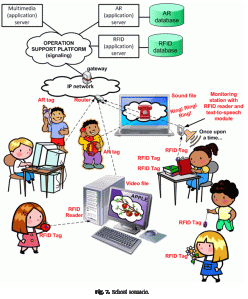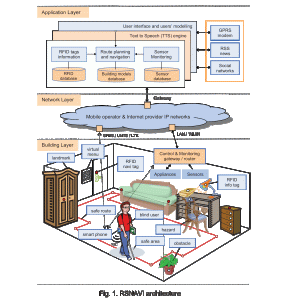Introduction
The Internet of things is a great solution for a wide variety of impairments. It is considered to be the future of technology and that should make it widely used by everybody, no matter if they have impairment or not. Already this fact should minimize stigmatization, as both people without and with impairments should be able to use the technology.
What is the Internet of things?
The term is rather new and has been around for about four years. It implies equipping objects that normally surround users on a day-to-day basis with tiny devices that collect information. These devices are connected to the Internet and are capable of drawing information from the World Wide Web in order to add value to the local information collected from the user. All this information is used in order to offer a service that asks from users a minimal or no effort at all.
The ideal dimension of the Internet of things makes it possible to imagine that objects can easily communicate between themselves and work together in order to offer services that are desired by the user but which are asking for only minimum input.
Among the technology used for supporting the Internet of things there are often listed Radio-frequency identification (RFID), near field communication, barcodes and digital watermarking. This makes the technology seamless and that is exactly what a great design should be. The active input from the user is minimum as the information is drawn through other methods. The result is maximal, as the possibilities that we have today could be expanded and improved, while the user’s effort is minimised.
The technology would be useful to people who don’t have an impairment but also for does who do. It would find its place in all homes. Most advantages seem to be for people who are blind, although not only.
One of the most common examples of how the Internet of things would work is that of a fridge that can recognize which products it contains and even order new food when it is about to finish. For example, the fridge would notice by itself that milk is almost over and order a delivery for the next day. Such a scenario sounds like a luxury for people who are not impaired but could be a very good supportive tool for people who are blind.
The great aspect about the Internet of things is that the technology is not present today and the leaves spaces for imagination to run wild. On the other hand, Internet is around for only a couple of decades. The iPhone has been launched only 5 years ago and is already mirrored in most other mobile devices present on the market. The iPad is here only for 3 years and it is difficult to think of the time when it didn’t exist. Simple and intuitive devices make their way into day-to-day activities leaving the feeling that they were always there.
From this aspect it is fair to say that the prognoses for the next years, for example, can and should be as innovative as possible, even if they are not possible today. As long as their usability level is incontestable they might just make their way through as solutions that feel like they have always been there.
Possibilities
The Internet of things is not one singular solution, but a cloud of different possibilities that have similar technology as base. Because of that, it is difficult to say how this cloud could take shape; it is just as difficult to cover it.
Covering all possibilities that the Internet of things has to offer in the subject of impairment design is not the object of this article. It is interesting, though, to take some ideal situations that reflect user needs and project possible solutions.
In order to identify relevant user needs I have looked at forums and articles that are discussing experiences and problems that people with specific impairments are facing. Conducting user studies would of course help give better shape to these scenarios, but that can be part of a larger project.
The path towards living in a world where Internet of things is present has already started taking shape, as there are companies that are focusing on developing such ideas / products.
Memory loss
– device which reminds about switching off the oven, for example, dangerous situations, explains sounds such as the fire alarm, doorbell. The device should be scalable to the type of memory loss level by an assistant so that it matches the person it should support.
– device which answers on questions which are asked repetitively
– finding lost objects. All objects should have an RFID tag that could be charged with various information. Finding out the keys’ position, for example, should also be just as easy as searching for them in a search bar and seeing on a map of the house where they are placed. A sound recognition system could be programmed to react on the question “Where did I put my keys?” and a couple variations on that with displaying a map of the flat with the position of the keys. Or a green light can be projected in the room on the spot where the keys are. It feels like the possibilities are endless.
– Finding out the history of objects that are found in the house. This can be seen as a Tale of Things and help rebuild reality as often as it is needed. (http://dl.acm.org/citation.cfm?id=2434674)
Visual impairment
– sensors on a belt which detect obstacles (how many steps until obstacle)
– interacting with a serious of services through voice recognition
– recognition of objects, their type, could be done through a table which has RFID recognition integrated which recognize the RFID tags of objects, together with the data that is loaded on them
– recognition of persons
– recognition of id cards, for example a policeman’s ID, which reduces the risk of being tricked
– recognition of sounds
– each building can have a map registered in an RFID tag at the entrance that an own device can connect automatically and provide sound options for finding specific destinations in the building
Scenarios
Some simple scenarios I found illustrated in the following article, where the following three illustrations are also extracted from:
http://lms.ctl.cyut.edu.tw/sysdata/22/27122/doc/571c22f5f635d883/attach/1523813.pdf
Google Glasses is already one step ahead the ideal situation envisioned in this research from 2012. What the article describes as an inserted artificial retina with a camera function can today be replaced by a pair of Google glasses that is connected to the Internet. No need to for surgery and insertion of technology into human body.
Shopping scenario
The shopping scenario is very interesting. A person who is blind can find out which fruits are displayed, or maybe if there are strawberries, where are they and how fresh they are through RFID tags. A class colleague was observing in a blog entry that it is impossible for a person who is blind to tell what cans contain and prices in general. RFID tags could contain all such information and more, such as validity date, country of provenience and maybe even ingredients, information which could be additionally provided to the user on request. More important, finding products on a shopping list could be possible by being indicated through a blind navigation system. This could use headsets indications or vibration response in the cane. And this could be used by persons who don’t have a disability as well. Who wouldn’t like to get some help when searching for their favorite type of packaged nuts or the soya sauce in a new supermarket?
Paying is also easy, as the person who is blind could check at all times which is the accumulated sum of products that are in his shopping cart. It is that sum that she/he knows should be paid in the end. The payment should then take place through mobile phone. The payment process should be as easy as possible. At the cashier the total sum is read out loud and authorized with a fingerprint recognition that the latest iPhone version already supports.
MIR:ROR
The possibilities are abundant. RFID tags can beset on any object and can be easily programmed to deliver any type of information may be needed when they are read. Some more inspiration can be found in the following link:
The MIR:ROR is not especially adapted to the needs of persons with impairments. Having to go to a website in order to program every stamp is tedious, especially as the website has not taken concern to non-exclusive design. What the MIR:ROR does is open the door for possibilities, as the technology is already present.
Indoor navigation system for people who are visually impaired
An indoor navigation system can also be developed. GPS has its limits when used in a closed indoor environment. I found a study that combined the use of Internet with RFID passive tags, Mobile phones with integrated Near Field Communication (NFC) interface, Voice-based navigation (they used Text-To-Speech (TTS) engine) and a System on Chip (SoC) for implementation of the Control & Monitoring Gateway.
More can be read about it at the following link
http://dl.acm.org/citation.cfm?id=2383322
Existing indoor navigation systems are limited and often disregard changes in the room’s layout. The system presented above, together with the possibility of connecting to a building’s data system with maps and that of identifying near objects through RFID tags, can make it possible to navigate without help in new environments as well. The system can be made as unnoticeable as it may be desired. Owning a cane is not a necessity. It can be used for signaling that the person is blind or for extra security, in case technology ever fails.
Conclusions
The Internet of things is a new concept and often looked upon as a futuristic layout of humans’ interaction with computers. Gathered information is scarce and still highly assumptive. At a closer look, though, technology already answers a high amount of that which is seen as desired scenarios. The tools are already here for making the scenarios possible. It’s just that they are not yet used at their best or that they lack a common language that would then help them communicate in order to deliver high results.
The technology is not particularly targeted to people that have a disability or to people that don’t have one. Everybody could profit from it and that is a clear advantage against stigmatization.




